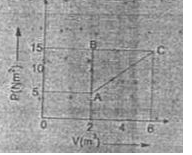The pressure of liquid is a linear function of volume (P = a + bV) and the internal energy of the liquid is U = 34 + 3PV find a, b, w, ΔE&ΔH for change in state from 100 Pa, 3m3 to 400 Pa, 6m3
To solve the problem step by step, we will follow the given conditions and equations.
Step 1: Identify the given values
We have the following initial and final states:
- Initial Pressure (P1) = 100 Pa
- Initial Volume (V1) = 3 m³
- Final Pressure (P2) = 400 Pa
- Final Volume (V2) = 6 m³
Step 2: Set up the equations for pressure
The pressure is given as a linear function of volume:
P=a+bV
Using the initial and final states, we can set up two equations:
1. For the initial state:
P1=a+bV1
100=a+3b (Equation 1)
2. For the final state:
P2=a+bV2
400=a+6b (Equation 2)
Step 3: Solve the equations for a and b
We can solve the two equations simultaneously.
From Equation 1:
a=100−3b
Substituting a in Equation 2:
400=(100−3b)+6b
400=100+3b
300=3b
b=100
Now substituting b back into Equation 1 to find a:
a=100−3(100)
a=100−300
a=−200
Step 4: Calculate the work done (w)
The work done during the process can be calculated using the external pressure, which is the average of the initial and final pressures:
Pexternal=P1+P22=100+4002=250 Pa
Now, calculate the work done:
W=−PexternalΔV
Where ΔV=V2−V1=6−3=3 m3
Thus,
W=−250×3=−750 J
Step 5: Calculate the change in internal energy (ΔE)
The internal energy is given by:
U=34+3PV
To find the change in internal energy ΔU:
ΔU=U2−U1=(34+3(P2V2))−(34+3(P1V1))
ΔU=3(P2V2−P1V1)
Calculating P2V2 and P1V1:
P2V2=400×6=2400
P1V1=100×3=300
Thus,
ΔU=3(2400−300)=3×2100=6300 J
Step 6: Calculate the change in enthalpy (ΔH)
The change in enthalpy is given by:
ΔH=ΔU+Δ(PV)
We already have ΔU=6300 J and we need to calculate Δ(PV):
Δ(PV)=P2V2−P1V1=2400−300=2100 J
Thus,
ΔH=6300+2100=8400 J
Summary of Results
- a=−200
- b=100
- Work done W=−750 J
- Change in internal energy ΔE=6300 J
- Change in enthalpy ΔH=8400 J
---
We have the following initial and final states:
- Initial Pressure (P1) = 100 Pa
- Initial Volume (V1) = 3 m³
- Final Pressure (P2) = 400 Pa
- Final Volume (V2) = 6 m³
The pressure is given as a linear function of volume:
P=a+bV
1. For the initial state:
P1=a+bV1
100=a+3b (Equation 1)
P2=a+bV2
400=a+6b (Equation 2)
We can solve the two equations simultaneously.
a=100−3b
400=(100−3b)+6b
400=100+3b
300=3b
b=100
a=100−3(100)
a=100−300
a=−200
The work done during the process can be calculated using the external pressure, which is the average of the initial and final pressures:
Pexternal=P1+P22=100+4002=250 Pa
W=−PexternalΔV
Where ΔV=V2−V1=6−3=3 m3
W=−250×3=−750 J
The internal energy is given by:
U=34+3PV
ΔU=U2−U1=(34+3(P2V2))−(34+3(P1V1))
ΔU=3(P2V2−P1V1)
Calculating P2V2 and P1V1:
P2V2=400×6=2400
P1V1=100×3=300
ΔU=3(2400−300)=3×2100=6300 J
The change in enthalpy is given by:
ΔH=ΔU+Δ(PV)
Δ(PV)=P2V2−P1V1=2400−300=2100 J
ΔH=6300+2100=8400 J
- a=−200
- b=100
- Work done W=−750 J
- Change in internal energy ΔE=6300 J
- Change in enthalpy ΔH=8400 J
Topper's Solved these Questions
Similar Questions
The pressue of a fluid is a linear function of volume (P=a+bV)and the internal energy of the fluide is
U=34+3PV(S.I.units). Find a,b,w, ΔE and q for change is state from (100Pa,3m3) to
(400Pa,6m3)View SolutionAn ideal gas occupies a volume of 2m3 at a pressure of 3×106 p,a the energy of the gas is :
View Solution
Knowledge Check
- Question 1 - Select One
Pressure of a liquid is linear function of volume P=a+bV. Calculate work done for change in state form (1bar,2L) to (2bar,5L):
A+810JB−450JC−810JD+450J - Question 2 - Select One
The pressure of a gas is 100 k Pa. if it is compressed from 1 m3 to 10dm3 , find the work done .
A990JB9990 JC9900 JD99000 J - Question 3 - Select One
Vapour pressure of solution containing 2 mol of liquid A (P∘A=80 torr) and 3 mol of liquid B (P∘B=100 torr) is 87 torr. We canconclude that
Athere is negative deviation from Raoult's lawBboiling point is higher than that expected for ideal solutionCmolecular attractions between unlike molecules arestronger than those between like moleculesDall of these statements are correct
Find the internal energy of air in a room of volume 40m3 at 1 standard atmospheric pressure.
View SolutionThe internal energy (U) ,pressure (P) and volume V of an ideal gas are related as U=3PV+4 .The gas is
View SolutionAn ideal gas is compressed at constant pressure of 105Pa until its volume is halved. If the initial volume of the gas as 3.0×10−2m3, find the work done on the gas?
View SolutionThe given figure shows a change of state A to state C by two paths. ABC and AC for an ideal gas. Calculate the ,

(a) Path along which work done is least.
(b) Internal energy at C if the internal energy of gas at A is 10 J and amount of heat supplied to change its state to C through the path AC is 200 J.
( c) Amount of heat supplied to the gas to gd from A to B, if internal energy of gas at state B is 10 J.
(ii) In an insulated contained 1 mole of a liquid, molar volume 100 mL. is at 1 bar liquid is steeply taken to 100 bar, where volume of liquid decreases by 1 mL. Find ΔE and ΔH for the process?
(iii) 14 g of oxygen at 0∘ C and 10 atm are subjected to reversible adiabatic expansion to a pressure of 1 atm. Calculate the work done in
(i) Litre atm.
(ii) Calorie (Given, CpCv=1.4).View SolutionWhen 100J of heat is given to an ideal gas it expands from 200cm3 to 400cm3 at a constant pressure of 3×105Pa. Calculate (a) the change in internal energy of the gas (b) the number of moles in the gas if the initial temperature is 400K, (c ) the molar heat capacity Cp at constant pressure and (d) the molar heat capacity Cv at constant volume. [R=253J/mol−K]
View Solution

